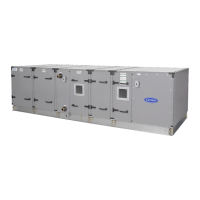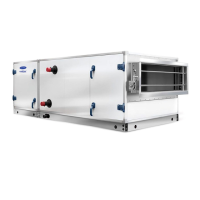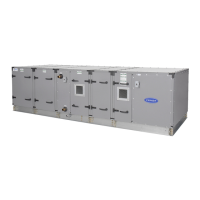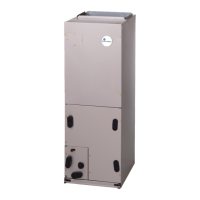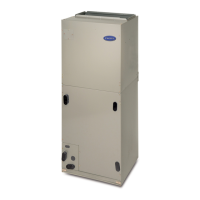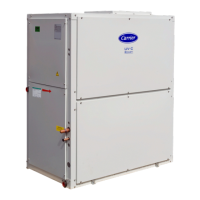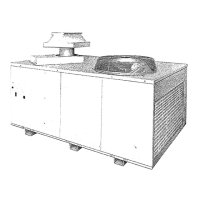SUCTION PIPING — Connect suction piping as shown in
Fig. 44 for face split coil or Fig. 45 for row split coil.
Suction line from coil connection to end of the 15-diameter-
long riser should be same tube size as coil connection to
ensure proper refrigerant velocity.
Refer to Carrier System Design Manual, Part 3, and size
remaining suction line to compressor for a pressure drop equiva-
lent to 2.0° F. This will provide a total suction line header
pressure drop equivalent to approximately 2.7° F. Refer to
Fig. 46 for piping risers to the compressor.
To minimize the possibility of flooded starts and com-
pressor damage during prolonged light load operation, an
accumulator can be used in the suction line of first-on, last-
off circuit.
The first-on, last-off circuits shown in Fig. 44 and 45
assume a single condensing unit. Note that in both figures
the last-on, first-off circuit is looped above the common re-
turn line to prevent oil entrapment in the non-operating coil
at partial load.
On face split coils with unequal size condensing units, the
largest condensing unit should be connected to the largest
coil (always the bottom coil on 39T units). This line is nor-
mally the first-on, last-off circuit.
THERMOSTATIC EXPANSION VALVE PIPING — Dis-
tributor nozzles are factory supplied. Thermostatic expan-
sion valves (TXVs) are field supplied. Be sure that correct
nozzle is installed in each distributor before installing
expansion valve. See Table 20 for factory-installed distrib-
utor nozzle sizes. UseAHU Builder™ program to select nozzles
for best performance; replacement nozzles must be field
installed.
Perform nozzle change-out procedure (if necessary) as
follows:
1. Field cut and remove end of distributor extension tube
outside cabinet panel as shown in Fig. 47.
2. Remove nozzle retaining ring with screwdriver or needle-
nosed pliers.
3. Remove nozzle from distributor by inserting 2 no. 6-32
threaded rods (at least 4-in. long) into the threaded holes
provided in the nozzle. See Fig. 48.
4. Insert correct nozzle into distributor body.
5. Re-insert nozzle retainer ring into distributor.
Install expansion valve as follows:
1. Wrap wet cloths around valve body to prevent excessive
heat from reaching diaphragm and internal parts. Do not
allow water to enter system. Disassemble expansion valve
before soldering, if accessible, for easy reassembly. Use
95-5 tin-antimony soft solder.
2. Solder expansion valve to distributor extension tube. Ex-
tension tube should be as short as possible. See Fig. 47.
3. Solder expansion valve equalizer line to suction line and
locate control bulb on suction line as in Fig. 44 or 45.
4. Insulate expansion valve body, diaphragm assembly, and
control bulb area to prevent charge migration and exces-
sive condensation.
5. Install filter drier ahead of expansion valve to ensure sat-
isfactory valve operation.
6. If hot gas bypass is required, see the following Hot Gas
Bypass section.
LEGEND
TXV — Thermostatic Expansion Valve
Fig. 44 — Face-Split Coil Suction-Line Piping
LEGEND
TXV — Thermostatic Expansion Valve
Fig. 45 — Row Split Coil Suction-Line PIping
Fig. 46 — Suction-Line Riser Piping
59

